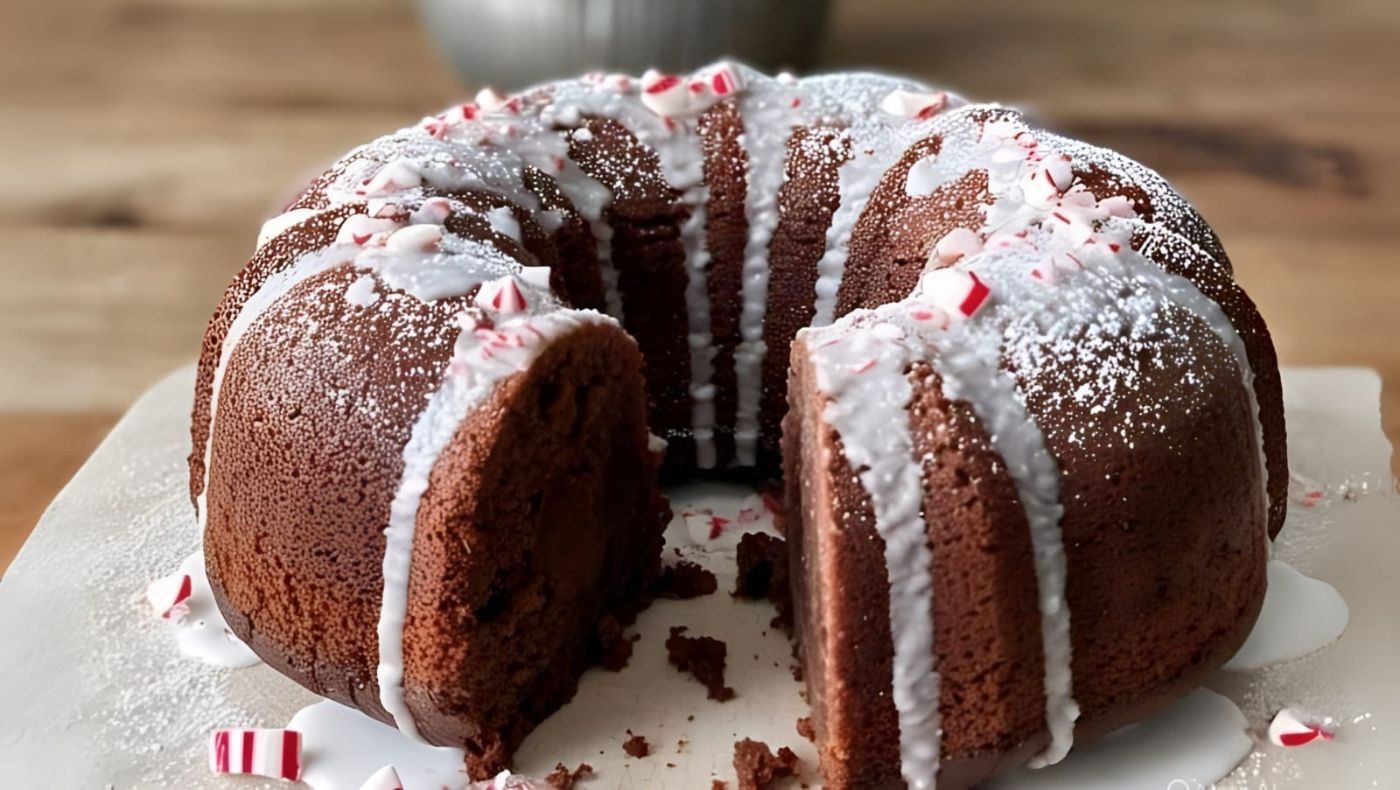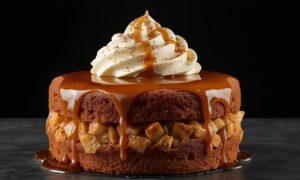Ever dreamt of a dessert that feels like a holiday hug? “Chocolate and peppermint classic comfort with a twist.” That’s exactly what you get with a Chocolate Peppermint Bundt Cake. It’s rich, moist, and filled with that cool, refreshing peppermint zing we all crave when the weather turns cold. Whether you’re hosting a holiday dinner or simply want to treat yourself, this cake is a showstopper. A festive favorite that brings warmth, joy, and a little sparkle to your table.
In this post, you’ll discover how to make the perfect Chocolate Peppermint Bundt Cake from scratch. I’ll guide you through each step mixing, baking, and decorating so you can bake with confidence. You’ll learn why certain ingredients matter, how to master the peppermint glaze, and how to keep your Bundt cake from sticking. This isn’t just a recipe, it’s a baking experience, filled with tips that’ll boost your skills and flavor game.
Each slice offers a rich cocoa base with a hint of cool mint in every bite. The glossy peppermint glaze drips beautifully down the ridges, catching the light and tempting every sweet tooth. Topped with crushed candy canes or chocolate shavings, this Chocolate Peppermint Bundt Cake brings beauty, flavor, and festive cheer all in one elegant dessert.
So if you’re looking to wow your guests or just want to fill your kitchen with the irresistible scent of cocoa and mint this Chocolate Peppermint Bundt Cake is your go to. Let’s make something unforgettable
Understanding the Foundation:
Ingredients & Substitutions
The secret to a perfect Chocolate Peppermint Bundt Cake lies in knowing how each ingredient functions and balances within the dense, sculpted form of a Bundt.
Chocolate Matters: Use high quality Dutch processed cocoa for a smooth, rich flavor that complements peppermint’s sharpness. Natural cocoa offers a brighter taste if preferred. To deepen richness, substitute up to one third of the cocoa with melted dark chocolate (70% cacao or higher), but reduce the liquid slightly. Add semi sweet chocolate chips for texture, just toss them in flour first to prevent sinking.
Perfecting the Peppermint: Always choose pure peppermint extract over imitation, it’s cleaner and more balanced. Start with 1 teaspoon per standard Bundt. Crushed peppermint candies can enhance both flavor and visual appeal. If needed, use peppermint oil at a 1:4 ratio, but carefully, it’s much stronger.
Structure and Texture: All purpose flour gives strength, but cake flour can create a softer crumb (just adjust amounts). Buttermilk adds moisture and amplifies chocolate depth through acidity. Eggs should be room temperature to ensure proper emulsion and lift. For vegan versions, use commercial egg replacers rather than flax eggs for better structure.
Fat for Flavor and Release: Use European butter for best taste and structure. If needed, replace up to half with vegetable shortening for easier release without compromising texture.
With these techniques, your Chocolate Peppermint Bundt Cake will achieve bakery quality results, moist, rich, and full of bold seasonal flavor.
Mastering the Method: Step by Step Professional Technique
The success of a Chocolate Peppermint Bundt Cake depends on precision and proper technique. Unlike layer cakes, Bundt cakes require careful handling due to their intricate shape and dense texture.
Prep Like a Pro: Grease every crevice of your Bundt pan using butter and flour or baking spray with flour. Many pros use the “butter flour cocoa” trick to ensure easy release while preserving the chocolate look. Preheat the oven to 350°F (175°C), placing the rack in the lower third for even baking.
Mix Smart: Cream butter and sugar for 4–5 minutes until pale and fluffy, this step builds essential structure. Add room temperature eggs one at a time, mixing well. If the batter splits, keep mixing, it usually comes back together.
In another bowl, whisk flour, cocoa powder, baking soda, baking powder, and salt. Sift if needed to prevent bitter cocoa lumps.
Combine Carefully: Alternate adding dry mix and buttermilk to the creamed base, beginning and ending with dry. Mix gently to avoid overworking the batter. Stir in peppermint extract and optional mix ins like chocolate chips or crushed peppermint.
Bake to Perfection: Pour the batter into the prepared pan without smoothing the top completely. Gently tap the pan to remove air pockets. Bake 50–60 minutes, checking with a skewer, look for moist crumbs, not wet batter. Cool in the pan for 10 minutes, then turn out onto a wire rack.
With this method, your Chocolate Peppermint Bundt Cake will bake evenly, release cleanly, and deliver a moist, flavorful bite every time. It’s a foolproof process for a showstopping dessert.
The Science Behind the Perfect Bundt
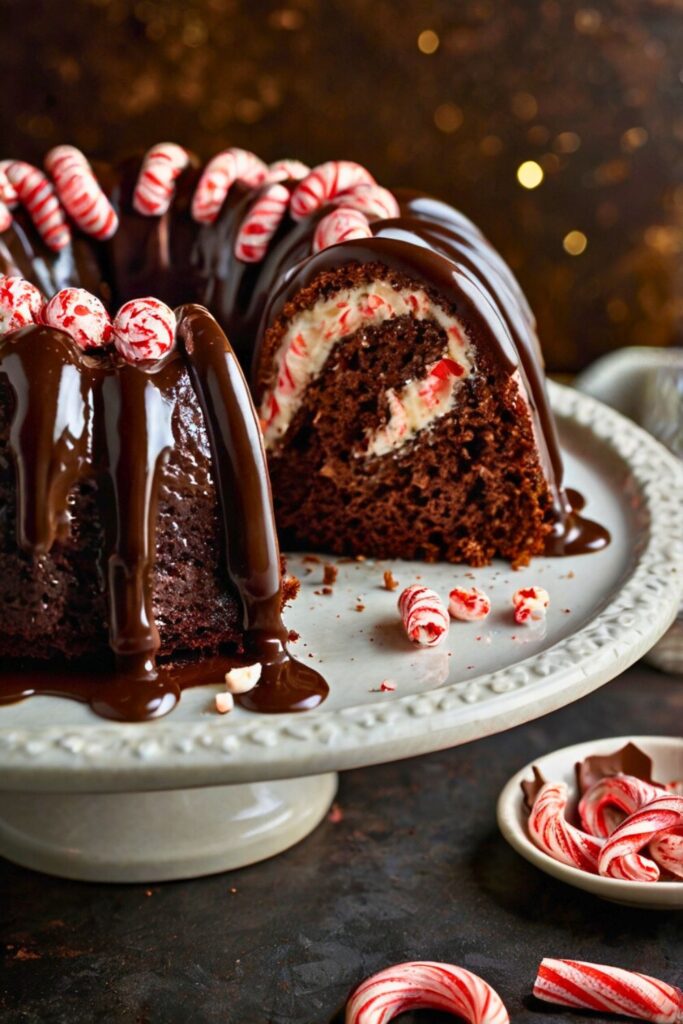
Understanding the science behind a Chocolate Peppermint Bundt Cake transforms baking into precision. The Bundt pan’s central tube promotes even heat from both inside and out, helping the dense batter bake uniformly. Its fluted design increases surface area, creating a crisp exterior that contrasts with the soft, moist interior.
Chocolate Chemistry: Cocoa powder plays a critical role in leavening. Natural cocoa’s acidity activates baking soda, while Dutch processed cocoa needs baking powder due to its neutral pH. Balancing these prevents dense or flat cakes. Higher fat content from butter or chocolate also helps retain moisture during longer baking times, essential for a perfect Chocolate Peppermint Bundt Cake.
Peppermint Precision: Peppermint extract contains oils that can fade during baking. Professionals often use slightly more extract in Bundt cakes to retain flavor. Since menthol intensifies as the cake cools, the peppermint flavor becomes more noticeable at room temperature, timing matters.
This scientific approach ensures your Chocolate Peppermint Bundt Cake bakes beautifully, tastes balanced, and delivers the right texture every time..
Essential Professional Tools and Equipment
The right tools elevate a Chocolate Peppermint Bundt Cake from good to exceptional. While basic gear works, professionals rely on specific equipment for consistent, high quality results.
Bundt Pan Selection: Not all pans perform equally. Heavy gauge aluminum ensures even baking, essential for a dense Chocolate Peppermint Bundt Cake. Nordic Ware pans stand out for their sharp details and reliable release. Lighter pans bake more evenly; darker ones brown faster, so time and temp may need adjusting.
Precise Temperature Control: An oven thermometer is a must, many ovens are off by 25–50°F. Use a probe thermometer to ensure the cake’s center hits 205–210°F. Digital scales offer unmatched precision by eliminating measuring errors, especially important in a delicate Chocolate Peppermint Bundt Cake.
Mixing Tools: Stand mixers with paddle attachments cream butter and sugar efficiently. Avoid whisks, which add too much air. Flexible rubber spatulas help distribute thick batter evenly in the pan and handle warm glazes with ease.
Using professional grade equipment helps your Chocolate Peppermint Bundt Cake bake evenly, release cleanly, and impress every time.
Presentation and Professional Plating Techniques
The visual impact of a chocolate peppermint bundt cake can make or break its professional appeal. Understanding presentation techniques transforms a simple cake into a stunning centerpiece worthy of high end establishments.
Glazing and Finishing Strategies A simple powdered sugar glaze enhanced with peppermint extract creates an elegant finish that highlights the cake’s architectural details. The key to professional glazing lies in consistency too thick and it won’t flow properly; too thin and it won’t provide adequate coverage or flavor impact.
For chocolate glaze alternatives, a ganache made with heavy cream and dark chocolate creates a luxurious finish, though it requires careful temperature control to achieve the proper pouring consistency. Adding a touch of corn syrup creates a glossy finish that photographs beautifully and maintains its appearance longer.
Crushed peppermint candies sprinkled over wet glaze add both visual interest and textural contrast. Professional tip: crush candies in a food processor for uniform pieces, then sift to remove powder that can make the garnish look dusty.
Plating for Professional Service Individual slices benefit from strategic saucing a small pool of chocolate sauce or peppermint infused cream on the plate creates visual anchor points and flavor enhancement. Dust the plate lightly with cocoa powder using a fine mesh sieve for professional presentation.
Height variations add visual interest to plated desserts. Consider adding a small quenelle of whipped cream or a delicate tuile cookie to create vertical elements that complement the cake’s horizontal presence.
Storage and Service Considerations Bundt cakes actually improve in flavor after a day, as the moisture redistributes and flavors meld. Store covered at room temperature for optimal texture. Refrigeration can dry out the crumb and dull the peppermint flavor.
For professional service, pre slice portions using a serrated knife warmed in hot water and wiped clean between cuts. This prevents the chocolate from smearing and creates clean, professional looking slices that photograph well and serve elegantly.
Pairing and Menu Integration
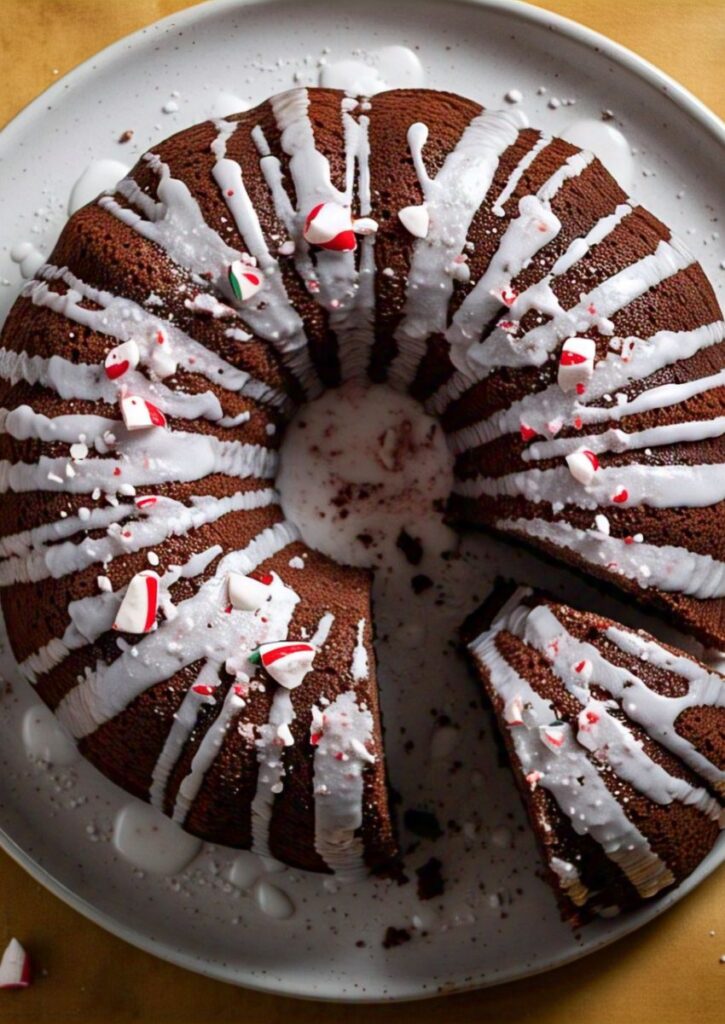
A well planned Chocolate Peppermint Bundt Cake does more than stand alone, it enhances an entire dessert program. Its bold flavor and striking presentation make it a centerpiece for seasonal or curated menus.
Perfect Pairings: Peppermint’s coolness opens up creative beverage options. Serve with hot chocolate and marshmallows for a cozy touch, or pair with peppermint tea for refinement. For adults, a mint julep adds sophistication. Choose medium roast coffee with chocolate notes to complement rather than overpower the cake. For wine, port or late harvest Riesling offers sweetness and acidity that balance the cake’s richness.
Seasonal Flexibility: While ideal for winter, you can adapt Chocolate Peppermint Bundt Cake year round. Use fresh mint in summer for a lighter profile, or garnish with berries in spring to add brightness and visual contrast.
Plating & Components: On tasting menus, pair it with vanilla bean ice cream or panna cotta. For crunch, add chocolate bark, tuile cookies, or candied nuts. These elements highlight the cake’s texture and flavor, making the Chocolate Peppermint Bundt Cake a dynamic part of any dessert experience.
Troubleshooting and Professional Problem Solving
Even experienced professionals encounter challenges with chocolate peppermint bundt cakes. Understanding common problems and their solutions separates true experts from those who simply follow recipes.
Structural Issues and Solutions Cake sticking to the pan remains the most common and frustrating problem. Prevention is always better than cure invest in quality pans and master proper preparation techniques. If disaster strikes and part of the cake sticks, carefully remove stuck pieces and “glue” them back with warm glaze or melted chocolate. This repair technique can actually create interesting textural variations when done skillfully.
Tunneling or large air pockets usually result from overmixing or incorrect leavening ratios. If you notice this pattern in your cakes, reduce mixing time and double check your baking soda and powder measurements and freshness dates.
Dense, heavy texture often indicates ingredient temperature issues or improper creaming. All ingredients should be at room temperature unless specifically noted otherwise, and creaming should continue until the mixture is visibly lighter in both color and texture.
Flavor Balance Corrections Overpowering peppermint can be difficult to correct after baking, but professional glazes can help balance the flavors. A chocolate heavy glaze with minimal peppermint can tone down excessive mint flavors, while vanilla based glazes can provide neutral sweetness that mellows the intensity.
Insufficient peppermint flavor is easier to address concentrate the peppermint in glazes, fillings, or accompaniments rather than trying to boost it in the cake itself.
Storage and Quality Maintenance Professional environments require understanding how bundt cakes age and change over time. Day old cake often has superior texture and flavor integration, but beyond three days, quality begins to decline noticeably.
Freezing can extend shelf life, but requires proper wrapping techniques to prevent moisture loss and flavor transfer. Wrap cooled cakes tightly in plastic wrap, then aluminum foil, and freeze for up to three months. Thaw slowly in the refrigerator to prevent condensation issues.
Advanced Variations and Professional Applications
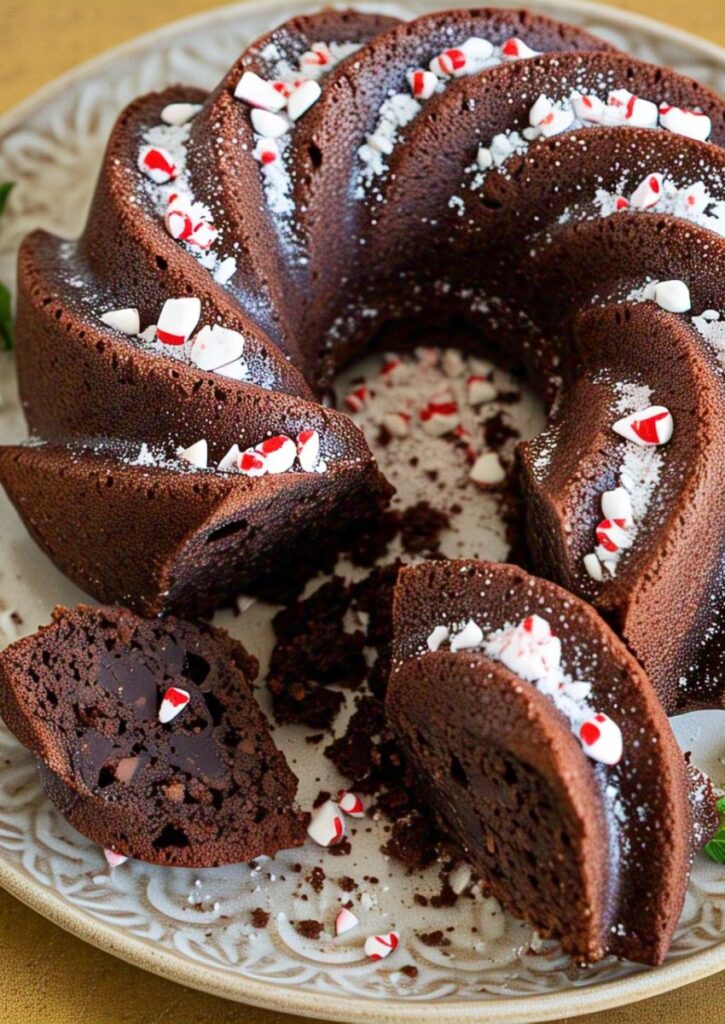
Mastering a basic Chocolate Peppermint Bundt Cake unlocks a world of professional variations to elevate your dessert game year round.
Flavor Adaptations: Enhance the chocolate base with orange zest for elegance or espresso powder for depth. Spices like cinnamon, cardamom, or cayenne add complexity, allowing each Chocolate Peppermint Bundt Cake to reflect your culinary signature.
Textural Twists: Add ins like chopped nuts, dried fruits, or crystallized ginger boost visual appeal and mouthfeel. Advanced bakers layer the batter with dark and white chocolate chips to create flavor depth and stunning cross sections.
Presentation Upgrades: Mini bundt cakes offer better portion control and faster, even baking. For upscale service, deconstructed versions, featuring cake crumbs, peppermint cream, and chocolate sauce, let diners explore textures and flavors interactively.
The Chocolate Peppermint Bundt Cake is more than a recipe, it’s a showcase of flavor balance, technical precision, and visual creativity. Bakers who master its structure and science can craft a dessert that’s adaptable across menus, seasons, and styles.
With the right skills and vision, a Chocolate Peppermint Bundt Cake becomes a signature showpiece, memorable, elegant, and undeniably professional.
Frequently Asked Questions
Q: Why does my chocolate peppermint bundt cake always stick to the pan, even when I grease it thoroughly?
A: Pan sticking usually results from inadequate preparation or incorrect cooling timing. Use the professional three step method: butter the pan thoroughly, dust with flour, then dust again with cocoa powder for chocolate cakes. Additionally, cool for exactly 10 minutes before turning out too short and the cake breaks apart, too long and it adheres permanently to cooled metal.
Q: How can I prevent my peppermint flavor from becoming too intense or completely disappearing during baking?
A: Peppermint extract volatility requires careful handling. Start with 1 teaspoon per standard bundt and taste the raw batter it should have noticeable but not overwhelming mint flavor. Remember that peppermint becomes more pronounced as the cake cools, so what tastes mild when warm will intensify at serving temperature. For insurance, reserve some peppermint intensity for glazes rather than loading it all into the batter.
Q: What’s the best way to store chocolate peppermint bundt cake for professional service over multiple days?
A: Store covered at room temperature for optimal texture and flavor development bundt cakes actually improve after 24 hours as moisture redistributes and flavors meld. For longer storage, wrap tightly in plastic wrap then aluminum foil and freeze for up to three months. Avoid refrigeration unless absolutely necessary, as it dries the crumb and dulls the peppermint flavor significantly.
Q: Can I make this cake ahead for large events, and if so, what’s the best timeline?
A: Absolutely bundt cakes are ideal make ahead desserts for professional events. Bake the cake 1-2 days before service and store covered at room temperature. Apply glazes or decorative elements on the day of service for best appearance. For very large events, cakes can be baked and frozen up to a month ahead, then thawed slowly in refrigeration 24 hours before final preparation.
Q: How do I achieve consistent results when scaling this recipe up or down for different event sizes?
A: Scaling bundt cakes requires careful attention to ratios and baking times. When doubling recipes, increase mixing times slightly to ensure proper incorporation, but don’t simply double baking time start checking for doneness at 1.5x the original time. For mini bundts, reduce baking time to roughly 25-35 minutes and check frequently. Always maintain the same oven temperature regardless of scale, as the chemical reactions require consistent heat for proper texture development.

Swiftly Captions by Tina Smith — Quick, flavorful food recipes made simple, bringing fresh inspiration to your kitchen every day
